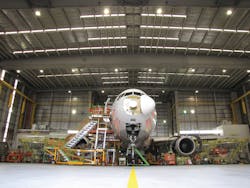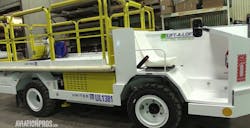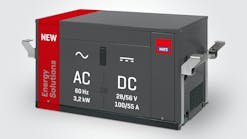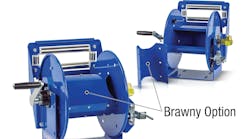The Time is Right: Electronic Tool Monitoring and Control Systems
Never has a greater emphasis been placed on the investment in aviation safety technologies and the attention and focus directed at effective training of the use of that equipment. According to International Air Transport Association (IATA), aviation had its safest year ever in 2013. More than 3 billion people flew safely on 36.4 million flights (29.5 million by jet, 6.9 million by turboprop). While considerable dollars are being willingly invested on engine monitoring systems, angle of attack indicators, GPS, and synthetic vision systems, tool control systems are often an afterthought.
A significant aviation industry disconnect exists as many companies have extensive software solutions and answers throughout their enterprise’s production environment. However, they don’t extend this technological capability through to electronic tool monitoring programs or systems. They’re relying upon older tool control methodologies that are costly and inefficient in today’s metrics accountability world. What worked in the past for tool control systems doesn’t cut it today. It’s time to rethink these pervasive paradigms.
It is readily understood that maintenance-related accidents as a result of foreign object debris (FOD) are more likely to be fatal than accidents in general. The costs of engine FOD are staggering in both repair and out-of-service implications. Yet many of the same old tool control system methodologies live on. Why?
There are numerous dynamics at play when an operation begins investigating the development and implementation of an electronic tool control system. Capital expenditures are often the biggest hurdle. Investments in the production environment carry a far greater level of importance than maintenance in budgeting requirements. The tool ownership issue, employee or company-owned, and the issue of shared toolboxes are obstacles that can’t be avoided. A further impediment is the “that’s the way it’s always been done” pervasive perception that exists with management and mechanics alike. It doesn’t have to be this way. At HABCO, we’re seeing how airlines and aftermarket operations are building the business case, aligning with mechanics and realizing metrics returns by implementing robust electronic tool control systems. There is a lot to learn from a best-practices standpoint by those that are thinking about going all in with a significant and far-reaching electronic tool control system strategy.
There are several key steps to ensure that an electronic tool control system meets expectations, has buy-in from both management and the mechanics, and also allows for a tangible financial return on the capital investment. In the past, electronic tool control product solutions didn’t deliver on their broad marketing and sales claims. Product capabilities continue to evolve. A serious and well-thought-through approach to defining needs requirements is a key element in the process. Mechanics’ input and counsel needs to be factored in, together with a defined end state that management buys into. Here is what HABCO sees as mandatory in the planning and execution of a sound electronic tool control system program.
End state determination
HABCO has worked with Air New Zealand Technical Operations, as well as with other major domestic and international airlines and airframe manufacturers, to thoroughly review and understand all key stakeholder requirements. It involves engaging with every stakeholder who is actively involved in tool control systems – from individual tool use to investment spending decision making. Having a definitive plan for business deliverables and financial return helps justify a substantial investment. It all starts with a strong and compelling business case with defined expectations.
“The tool control system is good enough” misconception
Talk to any airline or aftermarket services company and they’ll say that they have tool control systems in place. Whether manual or an older electronic version, a lot has changed and evolved. What was once right isn’t the case today. Tool control needs to be viewed from a holistic approach that extends beyond what is currently in place. There is a general lack of awareness of the advances that have been made in today’s electronic tool control systems.
Analyze true tool control costs
Tool control is often viewed as being “soft” and not able to be fully tracked and implemented. Tool time and cost need to be carefully monitored for true financial implications on the operation. How many times are mechanics off the job in a sweep for a lost tool or searching for tools to complete a repair? Not to mention frequent trips to the tool crib or performing physical inventory of the tools themselves. It’s all manifested in decreased efficiency and increased cost. Fully understanding the true cost of a tool control program is mandatory.
Gaining mechanic buy-in
It begins with the maintenance mechanics, whether they use company-owned tools or their own. Tools are personal and mechanics have a unique connection to them. Anything that disrupts this association is seen as a threat. Many mechanics view electronic tool control systems as a lack of trust in their performance. It is critically important to fully inform them to gain their buy-in to the new system to ensure acceptance and behavior change.
Choosing the right electronic tool control system
There is a multitude of manufacturers offering various versions of tool control systems. The majority are major tool manufacturers offering a one-size-fits-all tool control system that is applicable for virtually every vertical industry segment. Few offer a true aviation-specific tool control system. The PinPoint Tool Control System from? HABCO offers uncompromising tool control system capability all the way down to the individual tool pocket. Designed in close collaboration with Sikorsky Aircraft, the PinPoint Tool Control System is ideally suited for the aerospace industry because it was designed by aerospace experts for aerospace experts. The wants and needs of aviation maintenance mechanics and management influences were taken into account throughout the engineering and design implementation phase. It’s a product that’s been thoroughly vetted and endorsed by aviation maintenance users.
Market validation - a true indicator
Air New Zealand Technical Operations, the award-winning aircraft maintenance, repair and overhaul organization of Air New Zealand, selected the PinPoint Tool Control System from HABCO. It's using the system to facilitate a wholesale maintenance and operational changeover to RFID technology to manage aircraft tools, improve efficiency, and deliver greater safety across the operation.
Air New Zealand Technical Operations comprehensively defined its tool control program to fully understand what the payback would be for the significant investment in the maintenance requirements of the B-787 Dreamliner that enters into service later this year.
An increased level of safety within maintenance operations was the considerable driver for Air New Zealand. “Tool control has long been recognized as a vital element in aviation safety. The PinPoint Tool Control System from HABCO minimizes the potential for foreign object damage while allowing us to realize substantial operational benefits. This new technology provides the potential to make a step change in the way we operate, and to improve our efficiency and safety margins,” states Tech Ops General Manager of Aircraft Maintenance, Viv de Beus.
Air New Zealand realized that although it had been using electronic tool tracking technologies throughout its maintenance facilities, there were newer and more aviation-centric electronic tool control solutions such as the PinPoint Tool Control System from HABCO. “Air New Zealand has used bar-coded electronic tool tracking technology for several years. This broad experience was used to develop real-world tests for the extensive testing and evaluation of new generation tool control technologies. The PinPoint Tool Control System was the clear choice,” states Auckland Performance Improvement Manager Murray Courtier.
Electronic tool control systems have come a long way in a very short period of time. There is no question that more advances are coming in the foreseeable future. What won’t change is the quest to always be safer and alleviate foreign object debris. It makes great business sense. Now is the time to implement a far-reaching electronic tool control methodology.
HABCO Industries is based in Glastonbury, CT. For more information visit www.habco.biz or www.pinpointtoolcontrol.com.






